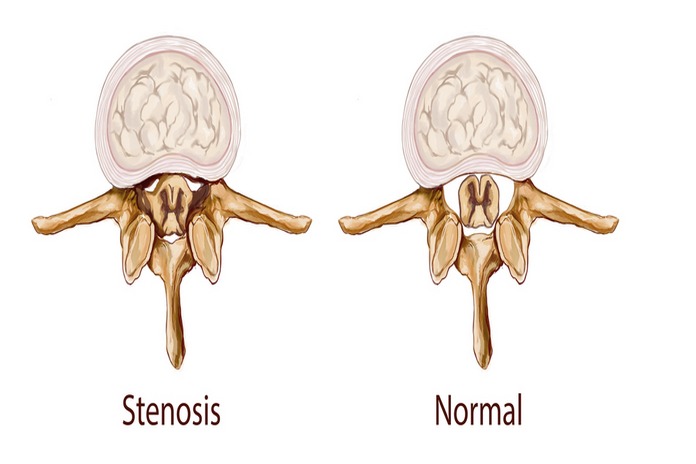Spinal Stenosis Pathophysiology

Pathophysiology of spinal stenosis is related to a combined mechanical compression and degenerative instability that cause spinal stenosis to manifest as cord dysfunction. Intervertebral disks degenerate and collapse with age, resulting in spurs. This mostly occurs at C5-6 and C6-7. This level shows a relative decrease in spinal motion, while levels C3-4 and C4-5 demonstrate an increase in motion. When physiological stresses are applied to the spine, osteophytes (bone growth) form at both the superior and inferior margins of the vertebral body. There are two types of osteophytes that forms as a result – anterior and posterior. Lateral recess stenosis can also be caused by posterior osteophytes. The result is an impingement of the spinal cord or nerve root. The hypertrophy of the facet joints and presence of synovial cysts may also be associated with arthritic degeneration, which compromises the patency of the neural foramina and spinal can even further. (2)
Stenosis of the lateral recesses and spinal canal are both caused by progressive narrowing of the central spinal canal. Cerebrospinal fluid (CSF) and dural membranes enclose the thecal sac, which are the essential contents of the spinal canal. There are several factors that can narrow the spinal canal without prior surgery, tumor, or infection. These may include uncovertebral joint hypertrophy in the neck, herniation of the nucleus pulposus posteriorly, bulging or protrusion of the intervertebral disc annulus, hypertrophy of the ligamentum flavum, hypertrophy of the facet joints, epidural fat deposition, thickening of the posterior longitudinal ligament, or spondylosis of the intervertebral disc margins.
As a result of the degeneration and abnormal motion, the cervical spine becomes unstable, leading to anterolisthesis and retrolisthesis. C3-4 and C4-5 are compressed by listhesis and C5-6 and C6-7 are compressed by spur formation. In many cases, this is accompanied by ligamentum flavum hypertrophy that comprises the posterior canal.
Repeated dynamic injury caused by normal neck movements further damages the cord. Spinal cord injuries and clinical myelopathy are caused by static and dynamic compression forces on the cord.
Segmental instability may result from disk desiccation and degenerative disk disease (DDD). Hypertrophy of the facet joints and vertebrae bodies occurs as a result of such instability. A hypertrophied IAP in the cephalad vertebral bodies promotes spinal canal stenosis in the central spinal canal. The ligamentum flavum hypertrophy, HNP, and narrowing of the disk space further decrease canal volume.
Foraminal stenosis and lateral recess can also be caused by the superior articulating process (SAP) of the caudal vertebral body. The L4 nerve root may be impinged in the foramen by facet hypertrophy, while the proximal nerve root sheath of the L5 may be impinged by lateral recess facet hypertrophy. Degenerative stenosis most commonly affects the two lower motion segments (L3-L4, L4-L5). A transition zone exists between the mobile lumbar spine and the rigid sacrum and the mobile lumbar spine. A lack of sagittal orientation in this area also makes the posterior joints more susceptible to rotational strains.
